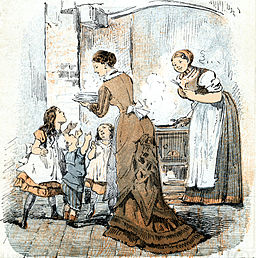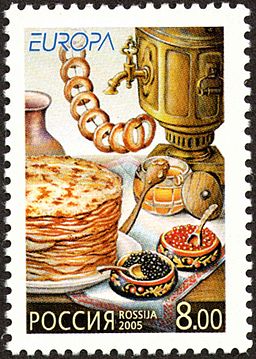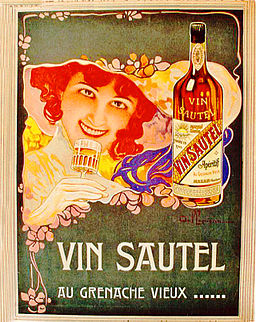 I guess you’ll have to decide for yourself. Here’s a link to ‘The 50 Funniest Food Cartoons at the New Yorker’ at ‘First We Feast’.
I guess you’ll have to decide for yourself. Here’s a link to ‘The 50 Funniest Food Cartoons at the New Yorker’ at ‘First We Feast’.
Month: August 2014
The I Hate to Cook Book by Peg Bracken
Peg Bracken. My mother had her book. My mother did not cook. Or at the least, she didn’t like to cook. Peg Bracken was one of a kind, and definitely worth reading.
Some women, it is said, like to cook.
This book is not for them.
This book is for those of us who hate to, who have learned, through hard experience, that some activities become no less painful through repetition: childbearing, paying taxes, cooking. This book is for those of us who want to fold our big dishwater hands around a dry Martini instead of a wet flounder, come the end of a long day.
When you hate to cook, life is full of jolts: for instance, those ubiquitous full-color double-page spreads picturing what to serve on those little evenings when you want to take it easy. You’re flabbergasted. You wouldn’t cook that much food for a combination Thanksgiving and Irish wake. (Equally discouraging is the way the china always matches the food. You wonder what you’re doing wrong; because whether you’re serving fried oysters or baked beans, your plates always have the same old blue rims.)
And you’re flattened by articles that begin “Of course you know that basil and tomatoes are soulmates, but did you know…” They can stop right there, because the fact is, you didn’t know any such thing. It is a still sadder fact that, having been told, you won’t remember. When you hate to cook, your mind doesn’t retain items of this nature.
Oh, you keep on buying cookbooks, the way a homely woman buys hat after hat in the vain hope that this one will do it.
Read more at the Hachette Publishing Group page here: http://bit.ly/1nM49Ey
Comrade V.V. Pokhlebkin’s Treatises on Russian Food
If you want to know anything about Russian food – and I mean extensively and thoroughly know – the man to go to is V.V. Pokhlebkin. Historian, academic, writer, foodie. Today I’m giving you a treasure trove in the form of a link to all of his writings online.
|
|
|
|
|
|
|
|
|
|
|
|
|
|
| Recipes of dishes of ethnic cuisine of the people of Russia and USSR. Russian national recipes. Recipes of dishes of Russian cuisine. Russian cuisine recipes. National recipes of the people of the USSR. |
Cooking with Fernet Branca by James Hamilton-Paterson
Some say this book is a cultural spoof. Others may read it ‘straight-up’. Either way, food is a strong element in this tongue-in-cheek novel. Recipes are tossed into the narrative at will and with whimsy.
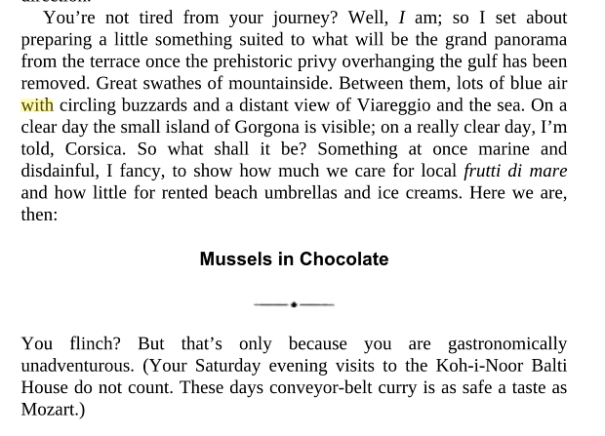 Read excerpts of Cooking with Fernet Branca on google books here.
Read excerpts of Cooking with Fernet Branca on google books here.
The Agrarian Standard by Wendell Berry
Wendell Berry writes on many things. Food is one of them.
The large agribusiness corporations that were mainly national in 1977 are now global, and are replacing the world’s agricultural diversity, which was useful primarily to farmers and local consumers, with bioengineered and patented monocultures that are merely profitable to corporations. The purpose of this now global economy, as Vandana Shiva has rightly said, is to replace “food democracy” with a worldwide “food dictatorship.”
To read the entire piece, go to Orion Magazine.
The Second Bakery Attack by Haruki Murakami
Murikami’s short story dances with deep hungers as it circles nonchalantly around a normal, everyday bakery.
I’m still not sure I made the right choice when I told my wife about the bakery attack. But then, it might not have been a question of right and wrong. Which is to say that wrong choices can produce right results, and vice versa. I myself have adopted the position that, in fact, we never choose anything at all. Things happen. Or not.
If you look at it this way, it just so happens that I told my wife about the bakery attack. I hadn’t been planning to bring it up–I had forgotten all about it–but it wasn’t one of those now-that-you-mention-it kind of things, either.
What reminded me of the bakery attack was an unbearable hunger. It hit just before two o’clock in the morning. We had eaten a light supper at six, crawled into bed at nine-thirty, and gone to sleep. For some reason, we woke up at exactly the same moment. A few minutes later, the pangs struck with the force of the tornado in The Wizard of Oz. These were tremendous, overpowering hunger pangs.
Our refrigerator contained not a single item that could be technically categorized as food. We had a bottle of French dressing, six cans of beer, two shriveled onions, a stick of butter, and a box of refrigerator deodorizer. With only two weeks of married life behind us, we had yet to establish a precise conjugal understanding with regard to the rules of dietary behavior. Let alone anything else.
Continue reading this story here at MIT.edu.
Corn: Our Mother, Our Life by Margaret Visser
One-ingredient histories have become an important part of our current reading and writing of food. Here’s one on corn – that ingredient both loved and hated – written way back in 1986.
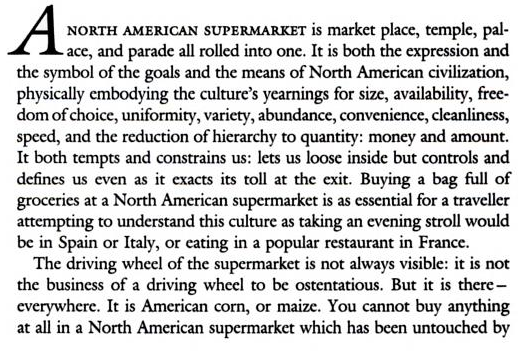 To continue reading go to Much Depends on Dinner by Margaret Visser, Chapter One.
To continue reading go to Much Depends on Dinner by Margaret Visser, Chapter One.
Short-Form Journalism: Food Celebrity Live Chat
As chefs, foodwriters and anyone else having to do with food (famous eaters, anyone?) become more celebrated in our culture, knowing what they’re up to is important. Here’s one way to find out: the short-form group interview – planned ahead by the writer to fit the style of the journal. This one went ‘live’ online.
THE NEW YORKER: Ok, let’s get started. Hello Burkhard, Lauren, and Calvin.
LAUREN COLLINS: Hello everyone.
BURKHARD BILGER: Howdy.
QUESTION FROM TIMOTHY: Do you do more eating when you’re working on a food piece than you normally do?
BURKHARD BILGER: Not always, but in this case my article was about home fermentation, so I spent a fair amount of time brewing stuff up: sauerkraut, sourdough, goat kefir. My kids kept telling me that I should write an article on Belgian chocolate instead.
LAUREN COLLINS: Hi, Timothy. The answer is yes! I thought I was going to develop gout after that trip to California with April and Ken.
QUESTION FROM TOMMY: Mr. Bilger, why is the FDA so bent on regulating bacteria?
Continue reading this article in The New Yorker: The Food Issue.
Tour de Gall by A.A. Gill
Restaurant reviews are – like recipes – an easily found form of foodwriting. Small-town newspapers usually have a writer ready to fawn over the ‘latest new place’ in well-practiced tones blending boosterism, civic pride, and desperation for a good meal. Then there are world-class restaurants . . . who draw writers capable of world-class criticism to be published in high-profile global magazines and journals. One of the best (and most biting) (yum, yum) is A.A. Gill, here writing of L’Ami Louis in Paris:
In all my years as a restaurant critic I have learned that there is a certain type of florid, blowsy, patrician Brit who will sidle up and bellow, with a fruity bluster, that if I ever happen to find myself in Paris (as if Paris were a cul-de-sac on a shortcut to somewhere else) there is this little place he knows, proper French, none of your nouvelle nonsense, bloody fantastic foie gras, and roast chicken like Bridget Bardot’s tits, and that I should go. But, they add, don’t bloody write about it. We don’t want Monsieur Yank and his good lady wife turning up in droves. It’s called . . .
Continue reading Tour de Gall at Vanity Fair.
The Garlic War by Annie Proulx
 “It is not really an exaggeration to say that peace and happiness begin, geographically, where garlic is used in cooking.” This is Marcel Boulestin’s claim. We’ll see about that – in this early story by Pulitzer-Prize winning author Annie Proulx.
“It is not really an exaggeration to say that peace and happiness begin, geographically, where garlic is used in cooking.” This is Marcel Boulestin’s claim. We’ll see about that – in this early story by Pulitzer-Prize winning author Annie Proulx.
Sometime back in the early ’30s my uncle Hubert finished his internship at one of the smaller hospitals in Poughkeepsie, New York, took a pretty young wife, Sophia, and set up practice in his mother-in-law’s rambling house on Garvin Street. His mother-in-law, whom everybody called Auntie Bella, was a formidable woman. She was, in the first place, large—not merely plump, not fat only, but tall, large-boned, and heavy-fleshed. She had a booming bass voice with which she sounded all her opinions to anyone who would listen. If no one would, she told her marvelous tales of the evil eye and of the time her cousin Giuseppe was robbed by bandits to the four cats who were constantly stalking in and out of the kitchen. The cats were swollen with pride and with tasty tidbits that Auntie Bella was always feeding them—a little dab of chicken cooked in a red sauce, for instance. “Here, cat … good, no?” And the cat would purr, gobble down the last shred, and stare greedily into the empty dish.
Continue reading ‘The Garlic War’ in Gourmet Magazine, 1964.
